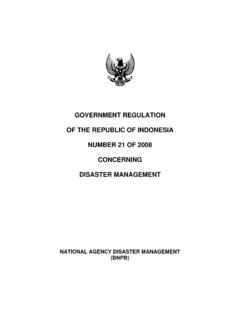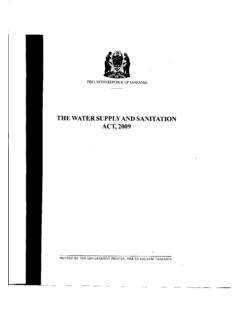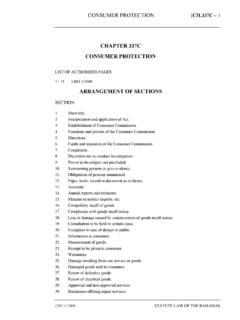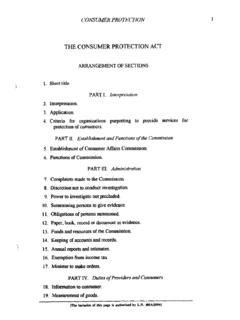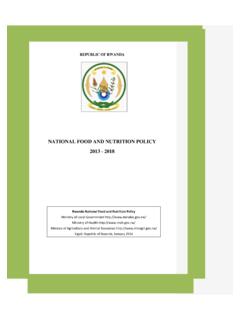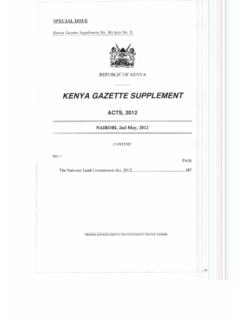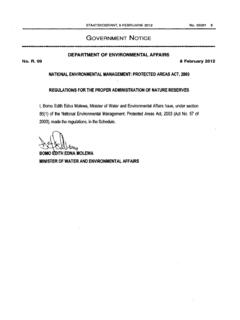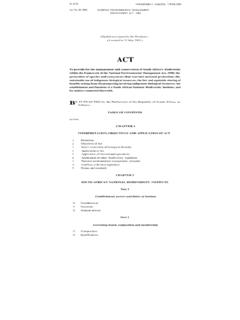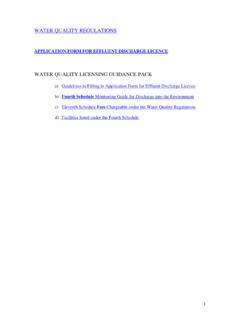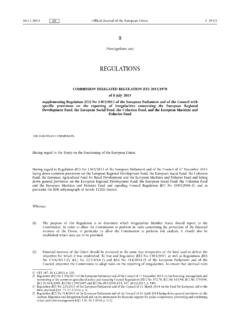Transcription of AGRICULTURAL SECTOR DEVELOPMENT STRATEGY - II …
1 UNITED REPUBLIC OF TANZANIA. AGRICULTURAL SECTOR DEVELOPMENT STRATEGY - II. 2015/2016 2024/2025. ii TABLE OF CONTENTS. List of Figures .. v List of Tables .. v CHAPTER ONE .. 1. INTRODUCTION .. 1. Rationale of the 1. National Guiding Policies .. 1. Background of the SECTOR DEVELOPMENT up to 2015 .. 2. Implementation arrangement .. 3. CHAPTER TWO .. 5. SITUATION ANALYSIS .. 5. Key Features of the SECTOR .. 5. Economic Contribution of the SECTOR .. 6. Status of Growth Drivers in the SECTOR .. 8. Water Resource Management and Irrigation .. 8. Mechanization .. 9. Rural Road and Electrification .. 10. Research and Extension 10. Financial 11. Private SECTOR DEVELOPMENT and trade .. 12.
2 Markets and Marketing Infrastructure .. 14. AGRICULTURAL SECTOR 's SWOT 15. Strengths and Opportunities .. 15. Weaknesses and Threats .. 16. CHAPTER THREE .. 18. VISION, MISSION AND GOAL .. 18. VISION (of the Agriculture SECTOR ) .. 18. MISSION (of the Agriculture SECTOR Ministries) .. 18. SECTOR GOAL AND OBJECTIVE .. 18. SECTOR Goal .. 18. Strategic Objectives .. 18. Summary of AGRICULTURAL SECTOR Constraints .. 19. CHAPTER FOUR .. 19. ASDS II 19. Strategic Areas for Intervention .. 20. SO1: Expanded Sustainable Water and Land Use Management .. 20. IR Water Use for Irrigation, Livestock and Fishery Made More Efficient and Inclusive .. 20. IR Land Use Planning and Watershed Management Improved.
3 21. IR Climate Change Mitigation and Adaptation Increased .. 22. SO 2 Improved AGRICULTURAL Productivity and Profitability .. 23. IR AGRICULTURAL Research Improved .. 23. IR AGRICULTURAL Extension Service Improved ..23. IR Access to Farm Inputs Increased .. 24. Increased Fertilizer and Improved Seed Application .. 24. ii ASDS-II: AGRICULTURAL SECTOR DEVELOPMENT STRATEGY 2015/15-2025/26. iii Promoted Artificial Insemination and Other Livestock Technologies ..24. Enhanced Aquaculture and Access to Fingerlings ..25. IR Access to AGRICULTURAL Mechanization Service Increased ..25. SO 3 Strengthened and Competitive Value Chain t .. 26. IR Farmer Organizations SO Agribusiness and Value Addition Promoted.
4 26. Value Addition ..26. Agribusiness and Private SECTOR DEVELOPMENT .. 27. IR Access to Markets and Rural Infrastructure Improved .. 27. Market Access .. 27. Trade: Domestic, Regional and International .. 28. IR Access to AGRICULTURAL Finance Expanded ..31. SO4 Strengthened Institutions, Enablers and Coordination Framework .. 32. IR Institutional Capacity Building and Coordination .. 32. Food Security .. 33. Nutrition Security .. 33. IR Disaster Management and Resilience 34. Key Priorities among the Strategic Areas of Intervention .. 36. Important Considerations for Selecting Priorities .. 38. Poverty Reduction and Improved Nutrition .. 38. Women and Youth Participation in Modernization.
5 38. Climate 39. Current Growth Rate .. 39. Farm Size Classes .. 40. Government Expenditure on Agriculture .. 43. Key Priorities .. 43. The Role of Science and Technology and Consequent Priority .. 44. (i) Research ..44. (ii) Extension ..45. Fertilizer Use by the Small Commercial Farmers .. 46. A Set of Further Priorities .. 48. (i) Irrigation ..48. (ii) Finance ..49. (iii) (iv) Agro-Processing and Improved Access to Markets ..51. (v) BIG RESULTS NOW (BRN) and Southern AGRICULTURAL Growth Corridor of Tanzania (SAGCOT) ..52. CHAPTER FIVE .. 54. MONITORING AND EVALUATION .. 54. Monitoring and Evaluation of the Growth Priorities .. 54. Six Percent Rate of Growth of AGRICULTURAL Output.
6 54. Ten Percent of Government Expenditure on Agriculture .. 55. Targeted Expansion of the AGRICULTURAL Research System .. 55. Targeted Expansion of the AGRICULTURAL Extension and Farmer Training Systems .. 56. Growth Rate of Fertilizer Use .. 56. Growth Rate of Irrigation .. 57. Mechanization .. 57. Big Results Now .. 57. A Cautionary Note on Monitoring .. 57. iii ASDS-II: AGRICULTURAL SECTOR DEVELOPMENT STRATEGY 2015/15-2025/26. iv Monitoring and Evaluation of the Seven Strategic Areas .. 58. Major instruments of monitoring and evaluation .. 58. National Sample Census of Agriculture .. 58. Annual AGRICULTURAL Sample 58. Routine Data 58. Joint SECTOR Review .. 59. CHAPTER SIX.
7 60. COST ESTIMATES .. 60. Cost Estimates for Priorities .. 60. Sources of Funds .. 61. CHAPTER SEVEN .. 62. IMPLEMENTATION ARRANGEMENT .. 62. Institution Framework .. 62. Coordination of ASDS .. 62. Implementation Organs of 63. Roles of Actors .. 64. Planning 64. AGRICULTURAL SECTOR Lead Ministries (ASLMs) .. 64. Regional Secretariats .. 65. Local Government Authorities .. 65. Commodity Boards and Other 65. Civil Society, Farmer Organizations and Cooperatives .. 66. DEVELOPMENT Partners .. 66. Annex 1: Results 67. Annex 2: Policy Gap Analysis .. 78. Bibliography .. 86. iv ASDS-II: AGRICULTURAL SECTOR DEVELOPMENT STRATEGY 2015/15-2025/26. v List of Figures Figure 1: Aggregate Economic (GDP) Growth by SECTOR .
8 Error! Bookmark not defined. Figure 2- Summary of TAFSIP Cost Estimates by Program Tanzania Mainland (TZS. 000,000) .. Error! Bookmark not defined. List of Tables Table 1 Trends of Mechanisation with Tractors in Tanzania .. Error! Bookmark not defined. Table 2- Thematic Area 1-Bi-Annual Outcome Indicators for Irrigation, Water and Land Management .. Table 3- Thematic Area 2-Bi-Annual Outcome Indicators for Productivity and Commercialisation .. Table 4- Thematic Area 3-Bi-Annual Outcome Indicators for Rural Infrastructure, Market Access and Trade .. Table 5- Thematic Area 4-Bi-Annual Outcome Indicators for Private SECTOR DEVELOPMENT .. Table 6- Thematic Area 1-Bi-Annual Outcome Indicators for Food and Nutrition Security.
9 Table 7- Thematic Area 6-Bi-Annual Outcome Indicators for Disaster Management and Climate Change .. Table 8- Thematic Area 7-Bi-Annual Outcome Indicators for Policy and Institutional Reform and Support .. Table 9: Summary of Programme Cost Estimates (in million TZS) Mainland Component .. Error! Bookmark not defined. v ASDS-II: AGRICULTURAL SECTOR DEVELOPMENT STRATEGY 2015/15-2025/26. 1. CHAPTER ONE. INTRODUCTION. Rationale of the STRATEGY AGRICULTURAL SECTOR DEVELOPMENT STRATEGY is an important guiding tool for implementation of the sectoral policies for the next ten years (2015/16 2024/25). It aims at operationalizing transformation of the AGRICULTURAL SECTOR into modern, commercial, highly productive, resilient, competitive in the national and international market which leads to achieving food security and poverty reduction, contributing to realization of Tanzania DEVELOPMENT Vision 2025 (TDV) that envisages raising the general standard of living of Tanzanians to the level of a typical medium-income developing country by 2025.
10 After the launching of the AGRICULTURAL SECTOR DEVELOPMENT STRATEGY (ASDS I, 2001), this STRATEGY is a revision of ASDS I based on the review of implementation of the Agriculture SECTOR DEVELOPMENT Program (2006-2014) and other various DEVELOPMENT efforts during the past period. In practical terms, the STRATEGY clarifies the issues that constrain the performance of AGRICULTURAL SECTOR and provides effective guidance on the public interventions that will coincide with private SECTOR DEVELOPMENT to meet the SECTOR DEVELOPMENT goals by 2015. National Guiding Policies For realization of TDV, both the Long Term Perspective Plan (2011-2025) and the First Five Year DEVELOPMENT Plan (2011-2015) provide guidelines and targets to be achieved by the AGRICULTURAL SECTOR in its contribution to the overall DEVELOPMENT plans of the country.
